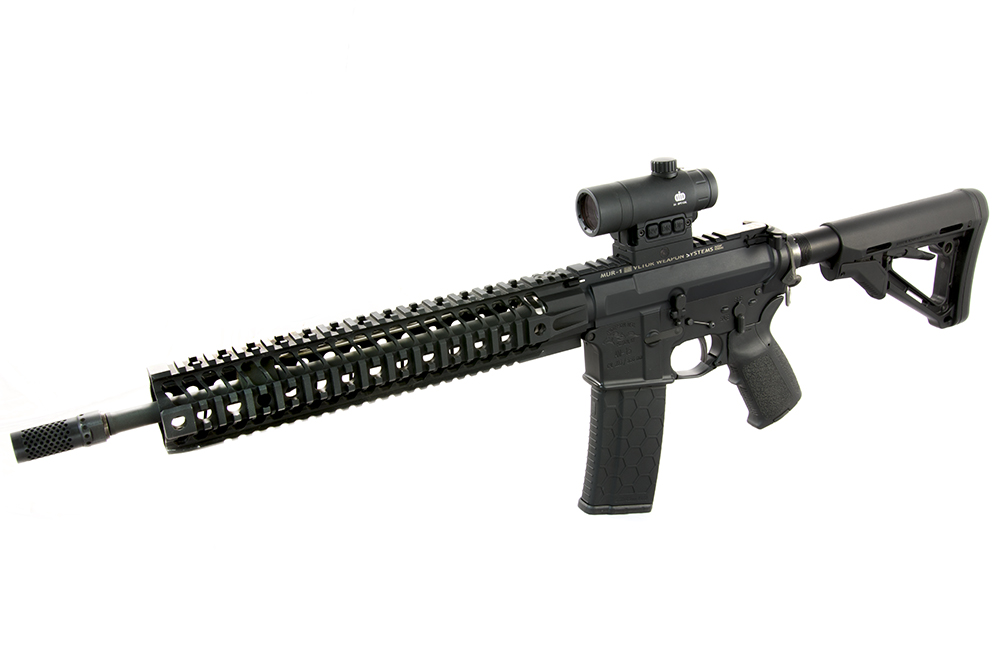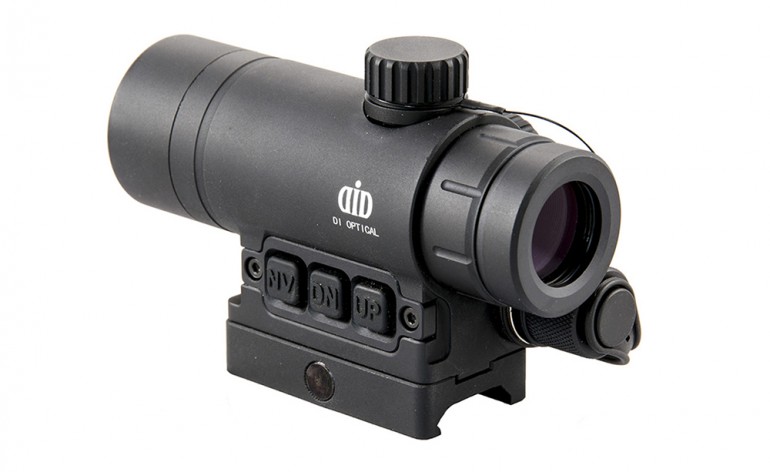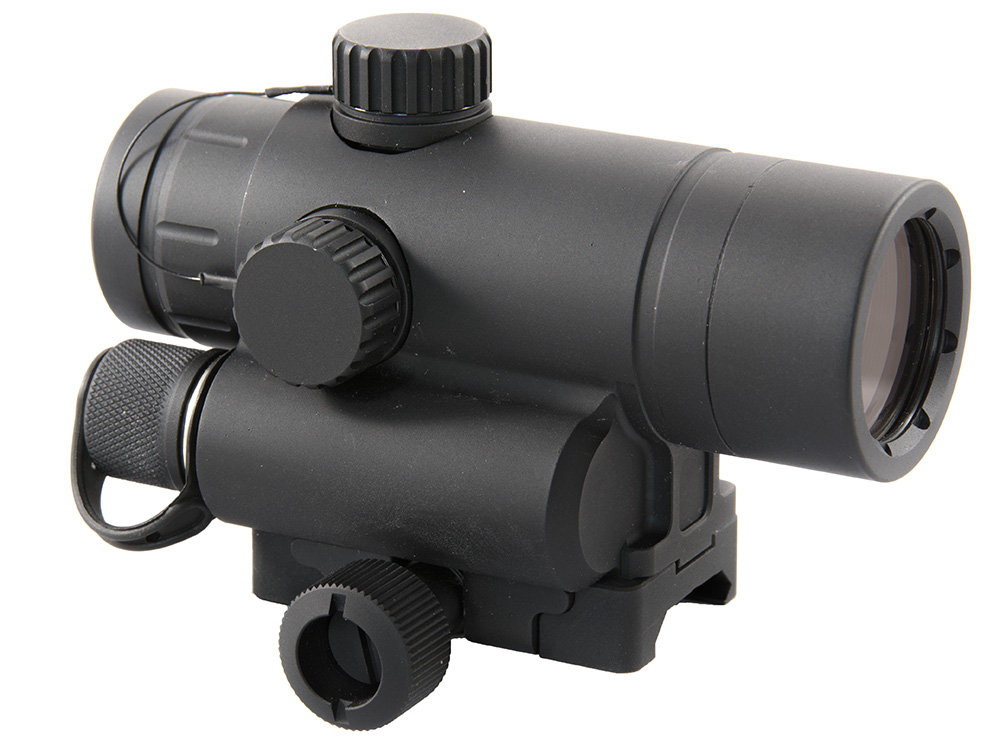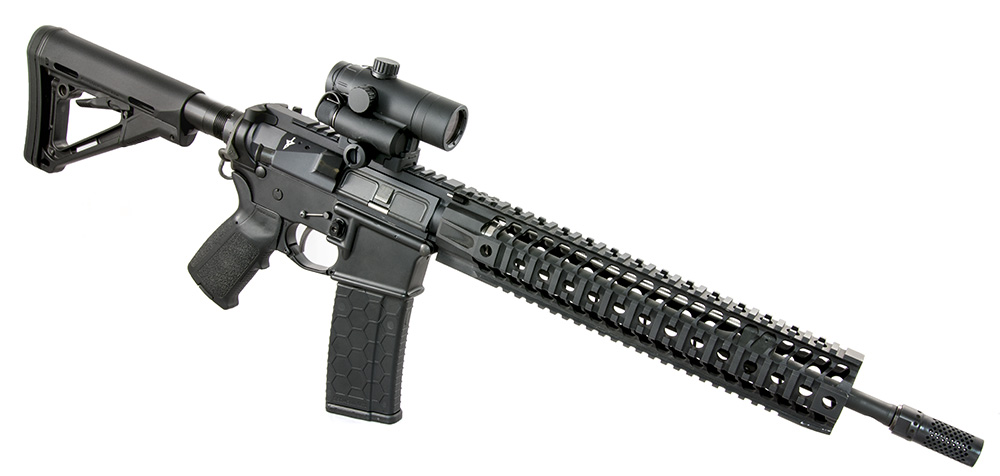DI Optical RV2 Red Dot Sight
Yet another excellent offering by DI Optical USA, this time in a more traditional body style that many shooters are used to seeing. It’s very pleasing to the eye (subjective) and has everything you need and nothing you don’t:
– Robust body, very solid feeling
– Traditional Side-Firing LED
– Standard lens reflective operation
– Wire-tied windage/elevation caps
– Push button operation
– It has Night Vision modes
– 1x AA Battery
DI Optical RV2 – Weight and Dimensions:
The DI Optical RV2 weighs 11.83oz with the battery installed. The RV2’s tube is 1.5″ thick on the outside. At its’ thickest point, the RV2 is 1-7/8″ thick (not including the mounting nut, which sticks out an additional 3/8″ on the right-hand side). With the OEM mount, the center of the view sits about 1-5/8″ from the top of the rail. It features a 30mm objective lens and a 25mm ocular lens.
DI Optical RV2 – FOV and Image Quality:
Once again, DI Optical has stayed true to their intent with providing high quality glass that doesn’t have a colored tint. In spite of having a red colored objective lens, looking through the sight shows zero coloration or tint. I don’t know many, if any, top tier Alpha brands doing this! The glass is clear and makes it look like you’re looking through a tube without glass, and I like it.
When moving the scope around in your hands while looking through it, there is a tiny bit of image shift/distortion, much like what you see when looking through sun glasses back and forth. But this is going to happen with any side fired red dot sight due to the internally angled lens which is intentionally positioned this way so that it reflects the LED back at your eye. When you have it mounted to your rifle, the image shift is indiscernible due to being stationary on the rifle. I am sensitive to this distortion and I have ZERO problems with the DI Optical RV2.

DI Optical RV2 – Parallax:
Side reflected red dot sights will always exhibit some parallax, in spite of what manufacturers may tell you. In the case of the DI Optical RV2, it appears to be on par with the rest of its’ competitors. My sample does exhibit very slight parallax, but it’s not enough to affect your shots….especially so when running and gunning. All red dot sights are intended for relatively close quarters, so to that end the amount of parallax is acceptable and won’t affect anything.
DI Optical RV2 – Technology and Brightness:
This is one area where the RV2 differs from other competitors that I have seen. I do not know why, but DI Optical USA chose to employ Pulse Width Modulation in this sight instead of Current Dimming. As I’ve mentioned in other posts, Current Dimming is my personal preferred method of altering LED brightness: This is because the electronics carries a constant stream of power to the LED and reduces or increases brightness by controlling the current. Regardless what level of current being supplied to the LED, it is constantly “on”. On the flip side, Pulse Width Modulation, or PWN for short, turns the LED on and off in rapid succession, such that the perceived effect is a dimmer or brighter dot depending on the length of time the “on” pulses are. The longer the “on” pulses, brighter the dot appears. The shorter the duration of the “on” pulses, the dimmer the red dot appears. The maximum brightness will be a constant “on”, just like Current Dimming. But switch the brightness just one step down, and PWN is activated.
The reason I go through this explanation on electronics is because I am susceptible to the effects of PWN. The effect I see is a flickering red dot when moving around. If you are susceptible to it, you may have seen this effect on certain car tail lights. Move your eyes quickly from one point to another, and the tail lights will appear to flicker. While I don’t know for sure what the exact reason is for why PWN was employed over the Current Dimming, I have a feeling it likely has something to do the RV2 having buttons vs a dial (just a guess). Fortunately, most people aren’t sensitive to this effect like I am, so this will never come into play with this sight, nor any device that utilizes PWM.
The brightness of the RV2 is similar to the DI Optical USA EG1, which I found to be less bright than an Aimpoint by a notch or two, but plenty bright enough on a bright sunny day. I never had problems searching for the dot: It always popped right up and felt very quick at target acquisition.

DI Optical RV2 – Controls:
One of the features of the DI Optical RV2 is that the controls are button-controlled. You typically see dials on red dots. In my opinion, this adds a classy looking interface without the big dial on the side. There are three buttons: NV, Down, and Up. While it doesn’t say how to turn it on and off, it was pretty easy to figure out: The Up button turns the red dot on, and pressing Down and Up at the same time will turn the sight off. Pressing the NV button will not turn the RV2 on. I have used buttons over dials before (Eotech), and it works well, but I suppose in the end it is up to your preference. On one hand, the dial can be turned really quickly to where you want to get to. But on the other hand, dials can be difficult to turn and create a large footprint on the side of the sight.
Once the sight is on, Pressing the NV button will activate Night Vision mode, and you have 7 different brightness settings. Pressing the NV button again will deactivate NV mode and the dot will be bright again. There are 7 Daytime settings: 8-9 are not usable in the daytime, 10-14 are daytime visible. On a bright sunny day, you will probably find yourself using setting 12-14, depending on your preference. Settings 8-9 are for evening/night time use without NV.
The buttons are places on the left side of the optic, which is nice because you can stick a magnifier behind the optic, if you so choose, and not have any issues using the button controls, like 512 Eotech models.
The windage and elevation adjustments are capped, but they are not finger adjustable. I don’t find this to be a problem in a red dot optic simply because I never find myself re-zeroing or playing with the adjustments once it zero’ed. This isn’t a scope that I need finger turrets for on-the-fly adjustments. It’s more of a “set it and forget it” kind of sight, as is every red dot sight for me.
DI Optical RV2 – Battery Life:
The DI Optical RV2 has pretty good battery life, and it can be extended significantly by using good batteries. Using a standard 1,175 mAh battery will give you nearly 1600 hours of use at peak brightness. However, a high end Energizer will more than double that to about 3400 hours. Settings 12, 13 and 14, the modes that I am assuming you will be using in the daytime, last 10,400 hours, 5600 hours and 3400 hours, respectively…..when using a high end battery. I am intentionally using ballpark numbers here because mAh varies in batteries significantly. But suffice it to say that using the RV2 at the highest settings will last for 425 days with 8 hours of use per day using a good battery.
One thing to note is that the RV2 will automatically power off with it doesn’t sense movement for longer than 10 hours. This is important to note if you are intending on leaving the sight on constantly while the rifle is stationary. I don’t know how sensitive the movement is….for instance, is driving in a car enough to keep it on? Or does the slightest little bump or shake reset the timer? Or does it take a shot of recoil to reset it? I have not been able to test this out.

DI Optical RV2 – Feel and Use:
When you hold the DI Optical RV2, you can tell right away that it has quality construction and was thoughtfully engineered. It is extremely solid and doesn’t feel like it would break easily. It sports a 32mm tube, giving an ample field of view. At the same time, it isn’t as generous as the EG1 which some people may prefer. When doing some fast heads-up shooting, I felt like the smaller field of view (in comparison to the EG1) sometimes helped hone in on the target a little easier. the smaller field of view made it so there was less to focus on and caused less distraction. I would suggest, however, that this is more of a preference. When it comes to non-magnified optics, field of view is much less critical in the decision making process. If you want a wider FOV, get your eye closer towards the diopter lens and you’ll see more. It doesn’t work this way with magnified optics though.
The dot is nice and crisp and has no noticeable blooming effects anywhere in the window. Compared to the EG1, the bezel around the ocular lens does seem thicker, but I notice this in basically all standard red dot sights. The larger window on the EG1 makes for a smaller bezel and tends to blur out and appear much thinner. If this is something you value, look into the DI Optical USA EG1….you would love it.

DI Optical RV2 – Price and Warranty:
The street price of the DI Optical RV2 is very attractive. I feel at the average $270 price range, you are getting a lot of red dot for your money! It’s low enough to gain market adoption by tempting people to branch out and try it vs paying top dollar for Alpha brand products. Plus, it has night vision modes and many sights don’t have this feature at this price. One thought I had was that Aimpoint PRO has come down in price the last couple years to be competitive with many other red dot sights, but it has fewer features and decreased specs than it’s more expensive brethren; namely battery life and night vision. My initial thought was, is $270, about $100-$150 cheaper than the Aimpoint PRO, low enough to tempt shooters away and try something new? I think in some cases, yes. But die hard fanboys will stay true and always argue that it’s better to save up for something tried and true.
Like all products manufactured by DI Optical USA, they provide a 1 year manufacturer’s defect warranty. This covers you if your RV2 fails under normal use circumstances. But throw it around, damage it by dropping it or anything self-inflicted and it will not be covered under warranty. I don’t make a habit of telling business how they should run their business, but as a newcomer into the U.S. market, I’m betting that it would really help sway people towards giving DI Optical a chance if the warranty terms were stronger. Vortex has the best warranty on the market and I personally know many people that buy their products simply because they don’t have to worry about accidentally breaking their product because they screwed up. Even second-hand purchases are covered! Now, I don’t pretend to know DI Optical USA’s financial situation and can imagine that this type of warranty might be an expensive proposition, but if they could financially swing such a warranty, I guarantee they would garner additional interest and grab some decent market-share.
Conclusion on DI Optical RV2 Red Dot Sight:
DI Optical USA has put out a great product with the RV2. As I said above, you get a lot of red dot for the money: Solid construction, easy controls, night vision capability, crisp dot with clean glass, and a standard AA battery with good battery life….what’s not to love? It also comes with scope caps, however I preferred to leave them off. If there’s any other drawback of this optic not yet mentioned, it’s the mounting system: I’d love to see a quick throw lever on this instead of the large screw knob sticking out of the side. It reminds me of the OEM ACOG mounts that I always replace. Yet this is a “want” that I wouldn’t expect at this price range: There are plenty of other red dot sights that cost more without this feature. And to be clear, the mount that comes with the sight gave me no problems. It stayed zeroed throughout my courses of fire. I just prefer the quick detach mounts.
The DI Optical USA RV2 has other nice touches, like wired elevation and windage caps. While they are not secured to the optic itself, they are tied together, so the only way you can lose the caps is if you had them both unscrewed at the same time. One suggestion to a future version update might be to create a small loop in the body that would secure the caps to the body of the sight so that they cannot accidentally be lost.
So at the end of the day, would I run the DI Optical RV2 on my rig? That’s usually the most pertinent question, yet filled with a lot of factors and preferences. But if asked to run a red dot for CQB shooting, I certainly wouldn’t hesitate or complain about running the RV2.
Check out DI Optical USA’s website link to the RV2 here: http://diopticalusa.com/?page_id=494


